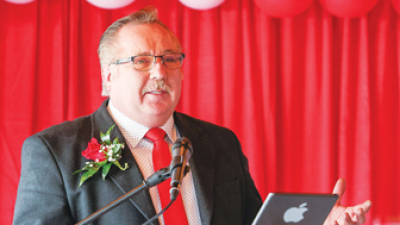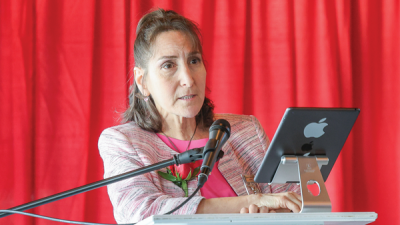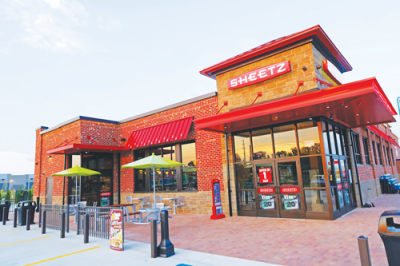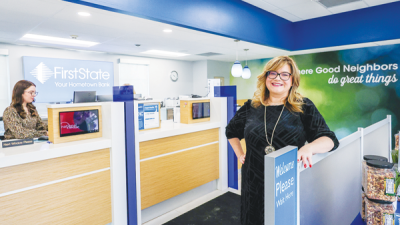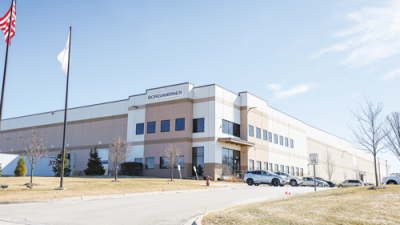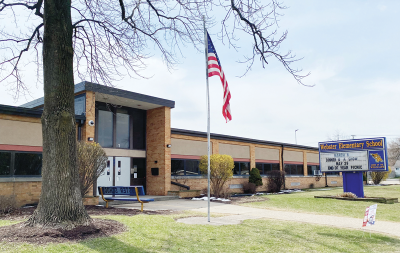
Webster Early Childhood Center — located at 431 W. Jarvis Ave. in Hazel Park — would be rebuilt into a new elementary school if voters approve a 30-year bond issue for $150,000,000 May 7.
Photo by Jenn Shelton
HAZEL PARK — On May 7, voters in the Hazel Park Public Schools district will decide the fate of a $150 million school improvement bond, to be paid over the next 30 years.
Officials say that if the bond is approved, taxpayers will see no increase in their school taxes and that the total millage rate will decline in time. But critics contend the plan is poorly defined with little community input, and that it asks for a commitment that is too big at a time of high inflation.
If approved, the bond will fund the construction of an elementary school (71,000 square feet) replacing Webster Early Childhood Center. Amy Kruppe, the district’s superintendent, said this is more cost-effective than making individual repairs at the school.
The bond would also pay for improvements at nine other sites in the district, with upgrades to safety and security, infrastructure and amenities.
By law, none of the funds can be used for employee salaries. The funds can also not be used for maintenance costs, or any other operating expenses. The funds can only be used for the projects described in the proposal.
If approved, the bond will extend the current millage for the entirety of the proposal, resulting in a zero-mill net increase from the current levy. The estimated levy in 2024 would be 5.65 mills, which is $5.65 on each $1,000 of taxable valuation. The estimated simple average millage to retire the bond debt is expected to be 9.42 mills.
Evaluating the need
The proposal was the result of an internal review in 2023, where school administration worked with architectural and construction management specialists to assess the condition of district facilities.
Together, they assembled a project list totaling more than $300 million. This was then cut in half to avoid a millage increase, Kruppe said. The items that made the cut were the ones that best addressed priority needs, such as safety and infrastructure.
One group opposed to the bond calls itself With Students In Mind. Rachel Noth, a former member of the Hazel Park Public Schools Board of Education (2015-22), is among its members.
Noth said that a separate study conducted in 2021 showed a need for only $36 million in maintenance repairs. When asked about this, Kruppe said that the 2021 study was not as thorough.
“In August 2023, we brought in our architect, and went through all the schools — building by building and room by room — with the school administrators present, reviewing the needs of each, and the features the staff would like to better educate the kids,” Kruppe said.
“Remember, bonds can only be used for infrastructure, and the money for this bond can only be used for that purpose,” Kruppe said. “Having the bond money for infrastructure would keep our general fund fully available for staff, materials and curriculum development.”
New construction
Due to its age, officials believe that renovating Webster Early Childhood Center — located at 431 W. Jarvis Ave. — would be more costly than new construction.
This led to the proposal for an entirely new building, one with a longer life expectancy and lower energy footprint, as well as enhanced security and learning spaces.
As for the early childhood services at Webster, they would be relocated to Hoover Elementary, a site chosen for the size of its classrooms, and the fact that many of them have restrooms attached.
Voters would also have input on the new elementary school. If the bond proposal is approved, the district will form a building planning committee that includes parents and staff representatives.
Noth expressed concerns about this point. She said that during a previous bond in the early 2000s, community members met and clearly defined projects such as rebuilding United Oaks Elementary and building Hazel Park Junior High, all before any votes were cast. By comparison, leaving the feedback process for the new elementary school until after the election feels rushed, she said.
“That’s one thing that gives me pause,” Noth said. “I was on the board that helped get the district out of deficit with our deficit elimination plan. We were in a position where the state wasn’t very favorable to us but gave us the opportunity to put together a plan, and we all buckled down to get ourselves out of deficit. And so when you feel there’s a big ask (like this bond) and there’s little collaboration to get things done, and we’re looking at taking on more long-term debt, it makes you feel like we’re on the wrong track again, and not staying the course for our families and community.”
A focus on security
The other projects include improvements at the former Hoover Elementary, Webb Elementary, United Oaks Elementary, Jardon Vocational School, Hazel Park Junior High School, Hazel Park High School, INVEST Roosevelt Alternative High School, the Ford Advantage Alternative School and Administrative Building, and Camp Hazelwood.
New safety and security features would be implemented districtwide, including the construction or remodeling of secure entrances, new exterior and interior doors with door locks, and new systems for public announcements. The high school would also receive a new emergency generator.
Kruppe said this point is particularly important.
“It was a different world in the 1950s when these buildings were first built. They didn’t have the same concern for safety that we do now,” she said. “Unfortunately, the entryways and locks from back then weren’t developed for what we need now. It’s my desire to bring all those infrastructure needs up front, because our kids deserve a safe and secure environment.”
There would also be learning space improvements, including upgrades to lighting, carpeting, furniture, ceilings, and restrooms in select classrooms, and a renovated auditorium at the high school featuring a new sound booth, lighting, and upgrades to audio and video systems.
Heating and cooling systems would be upgraded or replaced at locations across the district, including the replacement of boilers at select schools. Roofs and windows would also be replaced where needed, and there are also plans to replace the turf, track, home bleachers, scoreboard and press box at the high school. Outdoor learning spaces at select locations are also planned.
As for Camp Hazelwood, the restrooms, showers, bunkhouses, lighting and community spaces would all be updated, as would the outdoor learning spaces. Accessibility improvements would also be made, compliant with the Americans with Disabilities Act.
Questions remain
Noth said that her group is not opposed to the idea of a bond.
“I think the main concern I’m seeing is people asking, ‘Where is the middle ground with this?’ We want to know what we can do now to keep our buildings maintained in a fiscally responsible way, and without locking the community into a long-term debt of 30 years,” Noth said.
“The other thing that concerns us about the bond is that it’s very vague as to how the money is going to be controlled and how it’s going to spent,” she said, noting that while the law requires it to be spent on infrastructure projects, the finer details of each project are undecided. “If I’m going to be locked into a debt for 30 years, I want to know exactly how it will be spent and how it will be done.”
Noth also questioned the timing of the bond.
“You’re going to strap our community with a $150 million bond issue when this is the highest inflation in some time? People are already struggling to cover their regular tax bills and their other cost-of-living expenses. It seems a bit irresponsible to not take a more moderate approach here,” Noth said. “Tearing down a school and rebuilding it when our student population is declining doesn’t make sense. We could be focused on growing our programs and strengthening the benefits we have for our students.”
Kruppe said the bond will allow the district to focus on programs and curriculum development, since the district would be spending less of the general fund on infrastructure and would have more available for education. Combine that with facilities that are safer and more modern, and it should make the district more alluring for new enrollment, she said.
“It would have been easier to not bring a bond to the community, because we know taxes are high and people give to the schools and city already,” she said. “However, our kids deserve the best.”
For more about the Hazel Park Public Schools bond proposal, visit hazelparkschools.org/hps-bond.
The following is the language for the bond proposal as it will appear on the May 7 ballot:
School District of the City of Hazel Park School Improvement Bonding Proposal
County of Oakland
State of Michigan
Shall Hazel Park City School District, Oakland County, Michigan, borrow the sum of not to exceed One Hundred Fifty Million Dollars ($150,000,000) and issue its general obligation unlimited tax bonds therefor, in one or more series, for the purpose of: Constructing, equipping and furnishing a new school building, erecting, furnishing and equipping additions to and partially remodeling, furnishing and refurnishing, equipping and re-equipping school facilities; acquiring, installing, and equipping instructional technology for school facilities; constructing, equipping, developing and improving athletic facilities, playgrounds and play fields; and developing and improving sites.
The following is for informational purposes only:
The estimated millage that will be levied for the proposed bonds in 2024, is 5.65 mills ($5.65 on each estimated $1,000 of taxable valuation). The maximum number of years the bonds may be outstanding, exclusive of any refunding, is thirty (30) years. The estimated simple average millage anticipated to be required to retire this bond debt is 9.42 mills ($9.42 on each $1,000 of taxable valuation).
The School District expects to borrow from the State School Bond Qualification and Loan Program to pay debt service on these bonds. The estimated total principal amount of that borrowing is $3,384,559 and the estimated total interest to be paid thereon is $1,255,255. The estimated duration of the millage levy associated with that borrowing is 11 years and the estimated computed millage rate for such levy is 13 mills ($13 per $1,000 of taxable value). The estimated computed millage rate may change based on changes in certain circumstances.
The total amount of qualified bonds currently outstanding is $31,890,000. The total amount of qualified loans currently outstanding is $0.00.
Pursuant to State law, expenditure of bond proceeds must be audited, and the proceeds cannot be used for repair or maintenance costs, teacher, administrator or employee salaries, or other operating expenses.
 Publication select ▼
Publication select ▼


